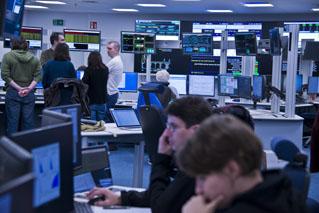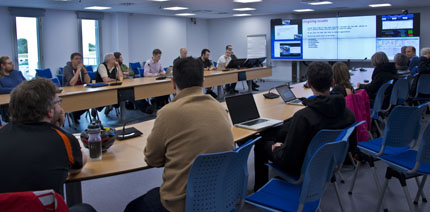This night the LHC collider has reached the “Stable Beam” state for the first time this year following the traditional LHC winter shut-down and the collider restart commissioning procedure. In “Stable Beam” conditions the experiments can switch on safely their sensitive sub-detectors. Therefore LHCb physicists were able to activate the tracking detectors as well as the Vertex Locator VELO and to observe particle tracks for the first time this year. The left image shows the LHC main information screen. The right image shows a typical event fully reconstructed during data taking. Particles identified as pions, kaon, etc. are shown in different colours.
Thanks to the joint effort between the SMB, EN and TE CERN departments in collaboration with LHCb, this year data taking is controlled from the new LHCb Control Centre presented in the left image below. The right image is a photograph of a meeting yesterday morning between LHCb physicists in preparation for today’s data taking.
Click the images for higher resolution.
The proton intensity in the first “Stable Beam” run was very small with only 3 proton bunches per beam. LHCb can nevertheless use the collected data for physics commissioning with low-intensity stable beams. It is planned that the intensity will be increased during the following runs this weekend. During the coming week the LHC commissioning will continue and the data taking will resume at the beginning of May with increased proton-proton collision intensity. During the first period of operation LHCb will profit from its revolutionary improvement of data acquisition and analysis developed a year ago. The calibration (precise determination of the relationship between the detector response and physical quantity being measured) and alignment process (determination of the relative geometrical locations of the different sub-detectors with respect to each other) now takes place automatically in the computer farm during data taking and the recorded data are immediately available for the physics analysis. Hence it will be possible to begin analysing the new data for physics measurements very rapidly.
Many exciting results have been reported on this web page. They are based on data collected during the three-year Run 1 and the first year of Run 2. In this, the second year of Run 2, it is expected that LHCb will collect substantially more data than in 2015. This larger sample will enable LHCb to obtain even more precise, interesting and, hopefully, surprising results, see video. As before follow LHCb data taking by watching live event display as well as live LHC and LHCb status pages.




